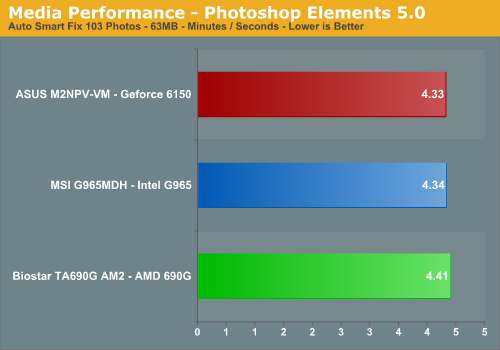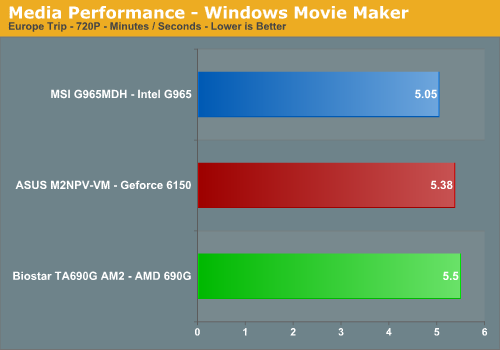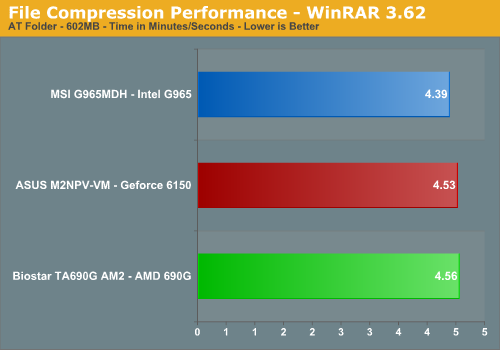Media Performance
We will take a brief look at general media performance with our test suite for that includes Adobe Photoshop CS3, Adobe Photoshop Elements 5.0, and Windows Movie Maker.
We utilize the widely available Retouch Artists Photoshop Speed Test for measuring platform performance in Adobe's Photoshop CS3. The benchmark applies a number of actions to a test image while we measure the total time elapsed during the active portion of the test. We set history states to 1, cache levels to 4, and CS3 was configured to make use of all available system memory. The scores reported include the full conversion process and is represented in minutes/seconds, with lower numbers providing better performance.

The results are once again interesting as we did not expect our AM2 systems to perform this well. Photoshop has favored the Intel Core 2 Duo greatly in the past and once again we are looking at a speed issue with the E6300 that allows the AM2 systems to be in the hunt.
Our next test is one recommended by Intel, but the test itself appears to be fair and results are very repeatable. This test simply measures the amount of time required to fix and optimize 103 different photos weighing in at 63MB. Time is measured in minutes and seconds, with lower times resulting in better performance:

This test not only stresses the CPU but also gives the storage systems a good workout. Our 6150 platform barely edges out the Intel platform in a test where sheer CPU speed can make up the difference in elegant design. That sounds so familiar, are we talking about the differences between Athlon 64 and P4 NetBurst or Intel Core 2 Duo and Athlon 64 X2? Either way you cut it, the 6150 once again finishes ahead of the 690G due to better storage system performance.
Next on the list is our Windows Movie Maker test that will meld our European vacation content (recorded off TV) into a newly downloadable file that can be viewed on our Xbox 360 in a pleasing 720p format. The values reported are in minutes/seconds for the conversion time, with lower numbers being better.

Our Intel platform has a significant advantage in this test with the 6150 scoring better than the 690G in a test that stresses both the CPU and storage system again. These results were interesting as previous testing with this application indicated our AM2 platform would be a little more competitive.
File Compression Performance
In order to save space on our hard drives and ensure we had another CPU crunching utility, we will be reporting our file compression results with the latest version of WinRAR that fully supports multi-treaded operations and should be of particular interest for those users with dual core or multi-processor systems. Our series of file compression tests utilizes WinRAR 3.62 to compress our test folder that contains 444 files, ten subfolders, and 602MB worth of data. All default settings are utilized in WinRAR along with our hard drive being defragmented before each test.

Our G965 platform basically zips away from our two AM2 platforms in this test that heavily stresses the CPU subsystem and at times the storage system. The Core 2 Duo has always excelled in this benchmark and once again shows its strength. We were surprised that our two AM2 platforms scored this well with the advantage going to the NVIDIA 6150 due to better storage system throughput in our opinion.
We will take a brief look at general media performance with our test suite for that includes Adobe Photoshop CS3, Adobe Photoshop Elements 5.0, and Windows Movie Maker.
We utilize the widely available Retouch Artists Photoshop Speed Test for measuring platform performance in Adobe's Photoshop CS3. The benchmark applies a number of actions to a test image while we measure the total time elapsed during the active portion of the test. We set history states to 1, cache levels to 4, and CS3 was configured to make use of all available system memory. The scores reported include the full conversion process and is represented in minutes/seconds, with lower numbers providing better performance.

The results are once again interesting as we did not expect our AM2 systems to perform this well. Photoshop has favored the Intel Core 2 Duo greatly in the past and once again we are looking at a speed issue with the E6300 that allows the AM2 systems to be in the hunt.
Our next test is one recommended by Intel, but the test itself appears to be fair and results are very repeatable. This test simply measures the amount of time required to fix and optimize 103 different photos weighing in at 63MB. Time is measured in minutes and seconds, with lower times resulting in better performance:

This test not only stresses the CPU but also gives the storage systems a good workout. Our 6150 platform barely edges out the Intel platform in a test where sheer CPU speed can make up the difference in elegant design. That sounds so familiar, are we talking about the differences between Athlon 64 and P4 NetBurst or Intel Core 2 Duo and Athlon 64 X2? Either way you cut it, the 6150 once again finishes ahead of the 690G due to better storage system performance.
Next on the list is our Windows Movie Maker test that will meld our European vacation content (recorded off TV) into a newly downloadable file that can be viewed on our Xbox 360 in a pleasing 720p format. The values reported are in minutes/seconds for the conversion time, with lower numbers being better.

Our Intel platform has a significant advantage in this test with the 6150 scoring better than the 690G in a test that stresses both the CPU and storage system again. These results were interesting as previous testing with this application indicated our AM2 platform would be a little more competitive.
File Compression Performance
In order to save space on our hard drives and ensure we had another CPU crunching utility, we will be reporting our file compression results with the latest version of WinRAR that fully supports multi-treaded operations and should be of particular interest for those users with dual core or multi-processor systems. Our series of file compression tests utilizes WinRAR 3.62 to compress our test folder that contains 444 files, ten subfolders, and 602MB worth of data. All default settings are utilized in WinRAR along with our hard drive being defragmented before each test.

Our G965 platform basically zips away from our two AM2 platforms in this test that heavily stresses the CPU subsystem and at times the storage system. The Core 2 Duo has always excelled in this benchmark and once again shows its strength. We were surprised that our two AM2 platforms scored this well with the advantage going to the NVIDIA 6150 due to better storage system throughput in our opinion.










70 Comments
View All Comments
3 CUBED - Friday, March 9, 2007 - link
I have to mention power also. Considering that a HTPC is properly going to be on quiet a bit, I would like to se some info on the power draw, from these mobo's. The same goes in the roundup!! Also considering that the energy prices is headed only UP, even a little lower performance might be worth that in the long run!!Thanks Kasper.
MrNeutrino - Thursday, March 8, 2007 - link
Guys,First, the feedback:
Frankly I'm quite frustrated from waiting for a site like AT for the past half a year or more to come out with more mATX reviews (until this review, which is a start).
I realize there are a lot of gamers OCers out there - very many AT readers. However, there are many (just as many?) non-gamer enthusiasts hoping to run stock-speed,SILENT, SFF systems out there - myself for one.
While lesser known sites have reviewed many of these products, I (and others like me I know of) have been waiting for AT to publish SOMETHING in the mATX / C2D (current and long-standing performance champ depending on the system config.) category for months on end! I realize you have dedicated folks working for each review category. However, AT - a site as a whole - still seems to have enough bandwidth to publish back-to-back LCD and heatsink reviews in a matter of day or two each. Yet you seem to have held off on prioritizing mATX system reviews for some inexplicable milestone until yesterday. I recall reading a vague comment in one of your reviews around the end of the year regarding an 'upcoming' mATX review, if I remember correctly. In my opinion it was already too delayed a review. Little did I know I'd be waiting another two months for such a review.
Geez! Publish the review in parts if you must, but don't make your readers hold off for this long and think all is well! What's the point of releasing this type of review, months after products became widely available and just a few months before the next round of technology updates?!
-----------------------
Second is a set of requests for the (personally) much anticipated upcoming mATX review next week 'as well as' for future reviews:
Requests for the upcoming mATX review:
* Please try to include Asus P5B-VM. One of the currently best featured G965 MBs.
* Please include at least one C2D ATX MB for comparison! My vote is for Asus P5B-E. I can't stress this enough! I have yet to receive any 'quantitative' (read: benchmark backed) response in forums http://forums.anandtech.com/messageview.aspx?catid...">here) and http://forums.anandtech.com/messageview.aspx?catid...">here, on the following topics (quoting from my earlier posts):
- how do mATX boards compare to ATX boards "for non-gaming tasks such as video / audio editing, general productivity, multi-tasking etc.?"
- "How much of a performance hit does a G965 type mATX motherboard with integrated graphics incur as a result of sharing memory bus bandwidth with the CPU, for NON-GAMING benchmarks, compared to regular C2D ATX boards?" (Assuming of course, the user chooses to use integrated graphics vs. discrete solution and has that enabled in BIOS.)
Please BE SURE to adderss these and other such real-world topics and help make the review more meaningful for folks like me.
Requests for future reviews:
* Consider investing more time and effort in SFF / mATX / silent PC config based reviews! Yes, there is an audience out there...
* For a site this major and popular - both with readers and vendors - you need to seriously evaluate your time-to-publishing lags for some of these reviews - C2D mATX roundup review for one. I realize there are a million things you can review and only 24 hours in a day. Delayed reviews (compared to when the products came out) don't help your readers as much - think luxury car depreciation over time... :)
Thanks.
Gary Key - Thursday, March 8, 2007 - link
Hi,Your suggestions and comments are appreciated. I did reply in the forums this morning.
:)
MrNeutrino - Friday, March 9, 2007 - link
Thanks Gary.I appreciate you reviewing the feedback and requests in detail. Hopefully we'll see some follow-up action based on this as and where appropriate.
Also, thanks for replying to some of the key questions I've had around mATX vs. ATX boards. Lack of major performance delta is very good to hear about, at least for pre-Vista Windows OSes. Interesting.
Based on your comments in the forum posting re: Vista + IGP + memory latency, I am intrigued. If you are going to cover this in the upcoming review, feel free to say so and defer this question. Else I am curious what performance difference we are talking about between XP vs. Vista using IGP solutions? Any pointers to help with this comparison would be helpful in helping decide whether or not a Vista purchase is worthwhile from a performance standpoint in such categories / applications.
Also, have you transitioned to exclusively testing using Vista?
blawck - Wednesday, March 7, 2007 - link
I'm buying a small-form-factor PC with an Intel 965G motherboard (it was the only option), and I'm plugging in an NVIDIA 8800GTX video card. So, I was wondering how these IGP motherboards (specifically this Intel one) perform in general with a vidcard plugged in. Is performance on par with (or at least somewhere close to) that of full-size motherboards? Or am I getting screwed?Gary Key - Wednesday, March 7, 2007 - link
It depends on the board that you buy. The Gigabyte GA-965G-DS3 allows for a decent level of overclocking (330FSB) and memory options (CAS 3 operation), the overall performance difference will not be noticeable in day to day activities when compared to a more enthusiast level board. A base G965 board will not offer the same overclocking options and a couple of the boards only allow CAS 5 operation at DDR2-800, but once again, the performance delta overall will be less than 5% in most cases, nothing to be concerned about especially given your choice of video cards.blawck - Wednesday, March 7, 2007 - link
Great, thanks for the quick reply! This is a high-quality site =). The manufacturer is Maingear, and the board they're using for my system is simply identified generically as "Intel 965G Express," but based on your response, I have faith that I am, indeed, not getting screwed =). I've built all my previous machines, but I'm getting old and fat and lazy, so I figured I'd spend a few hundred extra and have someone do it for me. Not too worried about SLI or overclocking at this point...I'll accept whatever resolution I can run Oblivion in, as long as I can run it. Thanx again.chucky2 - Wednesday, March 7, 2007 - link
For the mATX review, you should include results for the Abit Fatal1ty F-I90HD.It's basically the 690G version for Intel CPU's...and that'd allow a direct comparison between Conroe and AM2 CPU's as the chipset would be the same.
Just a thought...
Chuck
P.S. Plus, I'm sure there's a good amount of people that'd like to run Conroe on a cheap but good mATX, and the Abit Fatal1ty F-I90HD looks to be about the best option out right now for that (albiet in limited quantities so far...), just too bad it doesn't have onboard Firewire (at least I don't think it does, didn't list it on the spec page), because then it'd have like everything one could want...
Gary Key - Wednesday, March 7, 2007 - link
We should receive that board next week. I will do my best to include in it the roundup.chucky2 - Wednesday, March 7, 2007 - link
Awesome if you can Gary, Cool if you can't......March looks like the month of motherboard reviews... :)
Chuck